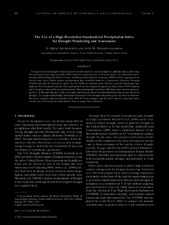| dc.creator | McRoberts, Brent | |
| dc.creator | Nielsen-Gammon, John | |
| dc.date.accessioned | 2016-10-28T20:37:32Z | |
| dc.date.available | 2016-10-28T20:37:32Z | |
| dc.date.issued | 2012-01-27 | |
| dc.identifier.citation | McRoberts, D. B., and J. W. Nielsen-Gammon, 2012: The use of a high-resolution SPI for drought monitoring and assessment. J. Appl. Meteor. Clim., 51, 68-83, doi:10.1175/JAMC-D-10-05015.1 | en |
| dc.identifier.uri | https://hdl.handle.net/1969.1/158243 | |
| dc.description | © Copyright 2012 American Meteorological Society (AMS). Permission to use figures, tables, and brief excerpts from this work in scientific and educational works is hereby granted provided that the source is acknowledged. Any use of material in this work that is determined to be “fair use” under Section 107 of the U.S. Copyright Act September 2010 Page 2 or that satisfies the conditions specified in Section 108 of the U.S. Copyright Act (17 USC §108, as revised by P.L. 94-553) does not require the AMS’s permission. Republication, systematic reproduction, posting in electronic form, such as on a web site or in a searchable database, or other uses of this material, except as exempted by the above statement, requires written permission or a license from the AMS. Additional details are provided in the AMS Copyright Policy, available on the AMS Web site located at (https://www.ametsoc.org/) or from the AMS at 617-227-2425 or copyrights@ametsoc.org. | en |
| dc.description.abstract | A high-resolution drought-monitoring tool was developed to assess drought on multiple time scales using the standardized precipitation index (SPI). Daily precipitation data at 4-km resolution are obtained from the Advanced Hydrologic Prediction Service multisensor precipitation estimates (MPE) and are aggregated on several time scales. Daily station precipitation data available from the Cooperative Observer Program (COOP) provide the historical context for the MPE precipitation data. Pearson type-III distribution parameters were interpolated to the 4-km grid on the basis of a regional frequency analysis of the COOP stations and L-moment ratios of the precipitation data. The resulting high-resolution SPI data can be used as guidance for the U.S. Drought Monitor at the subcounty scale in areas where local precipitation is the primary driver of drought. The temporal flexibility and spatial resolution of the drought-monitoring tool are used to illustrate the onset, intensity, and termination of the 2008–09 Texas drought, and the tool is shown to provide better county- and subcounty-scale information than do gauge-based products. | en |
| dc.language.iso | en_US | |
| dc.publisher | American Meteorological Society | |
| dc.title | The Use of a High-Resolution Standardized Precipitation Index for Drought Monitoring and Assessment | en |
| dc.type | Article | en |
| local.department | Atmospheric Sciences | en |
| dc.identifier.doi | JAMC-D-10-05015.1 | |


